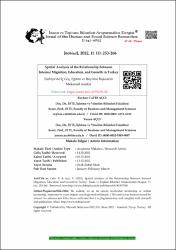| dc.contributor.author | Açcı, Reyhan Cafrı | |
| dc.contributor.author | Açcı, Yunus | |
| dc.date.accessioned | 2022-12-26T07:03:14Z | |
| dc.date.available | 2022-12-26T07:03:14Z | |
| dc.date.issued | 2022 | en_US |
| dc.identifier.citation | Cafrı, R. & Açcı, Y. (2022). Spatial Analysis of the Relationship Between Internal Migration, Education, and Growth in Turkey. İnsan ve Toplum Bilimleri Araştırmaları Dergisi, 11 (1), 253-266.
https://doi.org/10.15869/itobiad.937383 | en_US |
| dc.identifier.uri | https://doi.org/10.15869/itobiad.937383 | |
| dc.identifier.uri | https://dergipark.org.tr/en/pub/itobiad/issue/68190/937383 | |
| dc.identifier.uri | https://hdl.handle.net/20.500.12508/2469 | |
| dc.description.abstract | People have to migrate to find better jobs, survive for various reasons such as war, famine, and environmental factors, in other words, to have better living conditions. The impact of internal migration, which is considered to be an economic efficiency factor, on growth has been the subject of a limited number of studies. There are conflicting results in these studies regarding the effects of internal migration on growth. In addition, the studies ignore that growth and internal migration is a spatial phenomenon. In this context, the effect of internal migration on growth in Turkey for 2017 is investigated by spatial regression analysis based on 81 provinces. In addition to internal migration, the education variable was also taken into account in the analyzes. However, since it is important whether immigrants are skill-biased or not, the interaction variable is also used to represent the skill-biased labor force in the study. The interaction variable was obtained by multiplying internal migration and educational variables. As a result, spatial dependence exists and is important, both drawing visual attention from maps and the situation in question is supported by the Moran I Index and LM tests. The spatial lag model was found to be appropriate. According to the appropriate model determined, the impact of internal migration and education on growth was statistically significant and positive. It can be concluded that as the internal migration and education level increase, the growth of the provinces also increases. The interaction variable obtained by multiplying internal migration and education was also found to be statistically significant and positive. However, it seems that the interaction variable is greater in absolute magnitude than the education alone or internal migration alone variable. This shows that internal migration significantly increases growth when skills are biased. | en_US |
| dc.language.iso | eng | en_US |
| dc.publisher | İnsan ve Toplum Bilimleri Araştırmaları Dergisi | en_US |
| dc.relation.isversionof | 10.15869/itobiad.937383 | en_US |
| dc.rights | info:eu-repo/semantics/openAccess | en_US |
| dc.subject | Internal migration | en_US |
| dc.subject | Growth | en_US |
| dc.subject | Education | en_US |
| dc.subject | Spatial analysis | en_US |
| dc.subject | Skill-Biased labor force | en_US |
| dc.subject | İç göç | |
| dc.subject | Büyüme | |
| dc.subject | Eğitim | |
| dc.subject | Mekânsal analiz | |
| dc.subject | Beceri yanlı işgücü | |
| dc.title | Spatial Analysis of the Relationship Between Internal Migration, Education, and Growth in Turkey | en_US |
| dc.title.alternative | Türkiye’de İç Göç, Eğitim ve Büyüme İlişkisinin Mekansâl Analizi | en_US |
| dc.type | article | en_US |
| dc.relation.journal | İnsan ve Toplum Bilimleri Araştırmaları Dergisi | en_US |
| dc.relation.journal | Journal of the Human and Social Science Researches | |
| dc.contributor.department | Mühendislik ve Doğa Bilimleri Fakültesi -- Uluslararası Ticaret ve İşletmecilik Bölümü | en_US |
| dc.identifier.volume | 11 | en_US |
| dc.identifier.issue | 1 | en_US |
| dc.identifier.startpage | 253 | en_US |
| dc.identifier.endpage | 266 | en_US |
| dc.relation.publicationcategory | Makale - Ulusal Hakemli Dergi - Kurum Öğretim Elemanı | en_US |
| dc.contributor.isteauthor | Açcı, Reyhan Cafrı | |
| dc.contributor.isteauthor | Açcı, Yunus | |
| dc.relation.index | TR-Dizin | en_US |
















